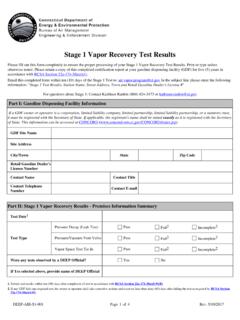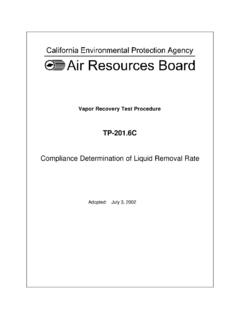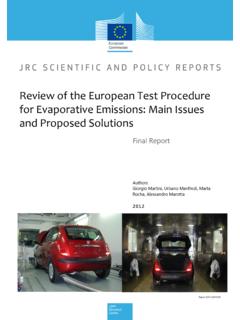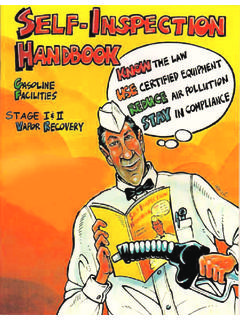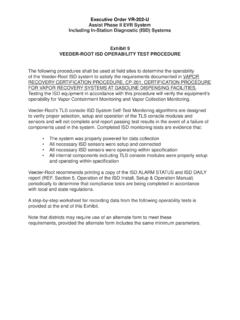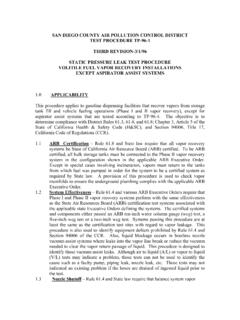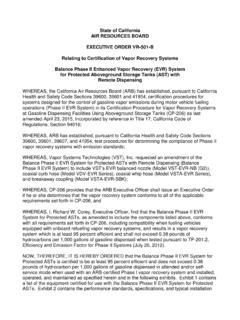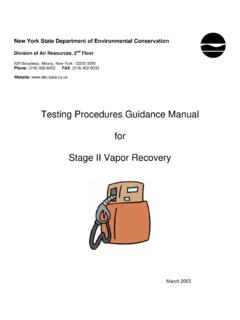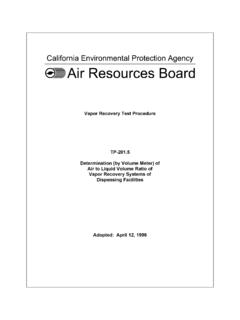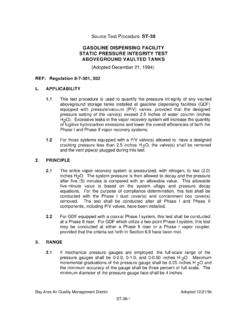Transcription of EPA 450/2-77-026 Control of Hydrocarbons from Tank Truck ...
1 (OAQPS NO. ) Control OF Hydrocarbons FROM TANK Truck gasoline LOADING TERMINALS Emission Standards and Engineering Division Chemical and Petroleum Branch ENVIRONMENTAL PROTECTION A Office of Air and Waste Management Office of Air Quality Planning and Standards a Research Triangle Park, North Carolina 27711 October 1977 OAQPS GUIDELINE SERIES The guideline series of reports is being issued by the Office of Air Quality Planning and Standards (OAQPS) to provide information to state and local air pollution Control agencies; for example, to provide guidance on the acquisition and processing of air quality data and on the planning and analysis requisite for the maintenance of air quality. Reports published in this series will be available -as supplies permit -from the Library Services Office (MD-35), Research Triangle Park, North Carolina 27711; or, for a nominal fee, from the National Technical Information Service, 5285 Port Royal Road, Springfield, Virginia 22161. Publication No.
2 EPA-45012-77-026 (OAQPS No. ) TABLE OF CONTENTS Page Chapter Introduction .. 1-1 Need to Regulate Tank Truck Terminals .. 1-1 Sources and Control of Volatile Organic Compounds from Tank Truck Terminals .. 1-2 Regulatory Approach .. 1-2 Chapter Sources and Type of Emissions .. 2-1 hydrocarbon Emission Points at Tank Truck gasoline Loading Faci 1ities .. 2-1 Leaks At Tank Trucks .. 2-3 Tank Truck Overfills .. 2-3 Back Pressure in Vapor Recovery Facilities .. 2-3 Vapor Holder tanks .. 2-3 Knock-Out tanks .. 2-3 Uncontrolled Emissions .. 2-4 Gasol ine Vapor Compositions .. 2-4 References .. 2-9 Chapter Applicable Systems of Emission Reduction .. 3-1 Methods of hydrocarbon Emission Reduction .. 3-1 Vapor Control Systems Source Tested by PA .. 3-1 Cornpression-Refrigeration-Absorption Systems . 3-4 Refrigeration Systems .. 3-4 Oxidation Systems .. 3-4 Leak Prevention from Tank Trucks .. 3-6 References .. 3-6 CostAnalysis.
3 4-1 Introduction .. 4-1 Purpose .. 4-1 ' 'Y. Scope .. 4-1 Use of Model Terminals .. 4-1 Bases for Capital and Annualized Cost Estimates 4-2 Vapor Control at Loading Racks .. 4-2 Model Terminal Parameters .. 4-2 Control Costs (Model Terminals) .. 4-4 Cost Effectiveness (Model T~rrninals) .. a-6a. Actual Costs .Comparison to Model ~stihit~~ ..4-9 References .. 4-in Chapter Effects of Applying the Technology .. 5-1 Impact of Control Methods .. 5-1 (I Air Pollution Impacts .. 5-1 Water and Solid Waste Impact .. 5-2 Energy Impact .. 5-2 References .. 5-2 Chapter Compliance Test Method and Monitoring Techniques .. 6-1 < Compliance Test Method ..6-2 Monitoring Techniques ..6-2 .. Affected Facility .. 6-4 Standard Format .. 6-4 Page Appendi'x A Emission Test Procedure for Tank Truck gasoline Loading Terminals .. A-1 A .2 Applicability .. A-1 A .3 Definitions .. A-1 Sunmary of Method .. A-2 Test Scope and Conditions Applicable to Test.)
4 A-2 A .6 Basic Measurements and Equipment Required .. A-3 Test Procedures .. A-5 Cal cul ati ons .. A-6 Calibrations .. A-7 Appendix B Sumary of Results for Tank Truck gasoline Loading Terminal Vapor Recovery System Testing .. B-1 References .. B-6 -- -- i Fage Table 2-1 Gornposi'ke Ana'fys-is of 75 Sample Motor Gasolines .. 2-6 abl F 2-2 :;.xaii+ i 2. Chw-1cal Cor$poi;i tion of Gasol i ne Vapors .. 2-8 Table 3-1 Exzmple: Vapor Cc:~trolSystem Operating Parameters .. 3-1 'Table 3-2 Summary of FA Tests at Tank Truck Terminals .. 3-5 ?-able 4-1 Gxt F'astors Used in Developing Annual i zed Cost Es!,tmr.,-tes for Model Terminals .. 4-3 T3bile 4-2 Cr!;-!~w''i Cost Estinrat~sfor Madel Existing Terminals .. 4-5 Table 4-3 Actual Control Costs for Bottom Fill Terminals .. 4-8 Tzble A-1 Casu? ifie Bulk Tra::sfer Terminal Data Sheet No. 1 .. A-10 a Tab1e A-2 G?sni i n,a Bul k Transfer Terminal Control System Data Sheet Nu, 2 ..,..,,,,..,.. A-11 %ai;!e 3"-i Surimr:~ of EPA lank Track gasoline Loading Terminal Vapor Recovery Tests.
5 8-5 LIST OF FIGURES Page .-Figure 2-1 gasoline Tank Truck Loading Methods .. + .. 2-2 Figure 3-1 Tank Truck Terminal gasoline Vapor Recovery .. 3-2 Figure 3-2 Terminal Oxidation System -.. 3-3 Figure 4-1 Cost Effectiveness for hydrocarbon Control at Existing gasoline Tank Truck Terminals .. 4-7 Figure A-1 Tank Truck gasoline Loading Vapor Control Schematic A-9 ABBREVIATIONS AND CONVERSION FACTORS EPA policy is to express all measurements in agency documents in metric units. Listed below are abbreviations and conversion factors for British equivalents of metric units for the use of engineers and scientists accustomed to using the British system. Abbreviations Mg -Megagrams kg -kilograms g -gram mg -milligram 1 -1 iters cm -centimeters Conversion Factors 1iters X .264 = gallons gallon X = liters mg/l X .008 = lb/1000 gallons Joules X X lo6 = kwh Joules X X loq4 = Btu gram X 1 X lo6 = 1 Megagram = 1 metric ton pound = 454 grams OC = .5555 (OF -32) x 1 INTRODUCTION.
6 >-This document is related to the Control of volatile organic compounds (VOC) from tank Truck terminals with daily throughputs of greater than 76,000 liters of gasoline . The Control techniques dis- cussed are more complex and more costly than those which are applicable to smaller bulk plants. Control techniques applicable to bulk plants are being covered in a separate document. The VOC emitted during gasol ine loading of tank trucks are primarily C4 and C5 paraffins and olefins which are photochemical ly reactive (precursors of oxidants). NEED TO REGULATE TANK Truck TERMINALS Many State or local regulations governing tank Truck terminals require vapor Control to reduce VOC emissions from tank trucks during gasol ine loading operations. Estimated annual nationwide emissions from loading gasol ine tank trucks at bulk terminals are 300,OOG metric tons per year. This represents percent of the 1975 estimate of total VOC from stationary sources. Control techniques guidelines are being prepared for those industries that emit significant quantities of air pollutants in areas of the country where National Ambient Air Quality Standards (NAAQS) are not being attained.
7 gasoline tank Truck terminals are a significant source of VOC and tend to be concentrated in areas where the oxidant NAAQS are 1ikely to be exceeded. SOURCES AND Control OF VOLATILE ORGANIC COMPOUNDS FROM TANK Truck TERMINALS Vo1 ati 1 e organic compounds (VQC) are displaced to the atmosphere when tank trucks are filled with gasoline . There are an estimated 300 vapor Control systems currently in operati~n at approximately 2000 tank Truck terminals in the Many of those Control systems were retrofitted to existing facilities. It has been assumed in this document that as a minimum Control measure (base case) all tank Truck gasoline loading terminals are equipped for either top-submerged or bottom-f ill (emission factor 600 mg/l ) . Top splash facilities are assumed to be equipped with a vapor Control system. If vapor Control systems are used at tank Truck delivery points (service stations, bu1 k plants, or commercial accounts), hydrocarbon vapor levels in tank trucks servicing these sources will approach saturation (emission factor 1400 mg/l).
8 In these situations, vapor Control systems will be more cost effective than in areas where tank Truck delivery point vapor Control systems have not been installed. Capital costs for a 950,000 liter per day tank Truck terminal are estimated to range from $176,000 ta $194,000 for a vapor recovery unit'and $140,000 for an incineration unit. Average annualized costs are estimated at $20,600 for vapor recovery and $29,800 for vapor i nci nera ti on. Recovered val ue i s approximately $ per liter. REGULATORY APPROACH The recommended tank Truck gasoline loading terminal emission limit @ that represents the presumptive norm that can be achieved through the appl ication of reasonably available contra1 technology (RACT) is C-80 milligrams of hydrocarbon per liter of gasoline loaded. Reasonably available Control technology is defined as the lowest emission limit that c a particular source is capable of meeting by the application of Control technology that is reasonably avail able cansideri ng technological and economic feasibility.
9 It may require technology that has been applied to similar, but not necessarily identical source categories. It is not intended that extensive research and development be conducted before a given Control technology can be applied to the source. This does not, however, preclude requiring a short-term evaluation program to permit the application of a given technology to a particular source. This a latter effort is an appropriate technology-forcing aspect of RACT. Monitoring terminal operational procedures and Control system operating parameters by visual observation and by the use of portable hydrocarbon detectors will ensure that liquid and vapor leaks are minimized. SOURCES AND TYPE OF EMISSIONS The purpose of this chapter is to identify and describe tank Truck gasoline loading processes currently in use and those processes likely to be installed in the future. When possible, emissions from each significant point source are quantified. hydrocarbon emissions from gas01 ine tank Truck terminal s may occur at storage tanks , tank trucks, points along the tank Truck vapor gathering system, and from the hydrocarbon vapor Control unit.
10 Tank Truck loading of gasoline may be by bottom fill, by top splash cr by submerged fill pipe through hatches on the tops of the trucks. (See Figure 2-71 hydrocarbon vapors displaced from tank Truck compartments are vented either directly to the atmosphere or to a gathering system and then to vapor Control equipment. Air and residual nyarocarDons are ventea directly to the atmosphere from the vapor Control equipment, hydrocarbon EMISSION POINTS AT TANK Truck gasoline LOADING FACILITIES. Potential points of hydrocarbon emissions are leaking flow valves, re1 ifsf valves, flanges, meters, pumps, etc. The overall effectiveness of vapor Control systems is dependent on the concentration of hydrocarbon vapors in the tank trucks, the degree of VOC capture at the Truck and the efficiency of the Control equipment. Several factors may influence capture and recovery efficiency of VOC at terminals. They are discussed below. -FLL PIPE VAPM EUl301L*4 --HATCH COVER r gasoline r vapors ~ VAPORS ,+.)










